How Does the Chinchilla's Native Habitat Affect Its Behavior in Captivity?

Chinchillas are crepuscular rodents native to the Andes mountains in South America. In the wild, they are social animals that live in colonies, which influences their behavior in captivity. Chinchillas are naturally active and agile, with a strong need for mental and physical stimulation. Providing a spacious enclosure with plenty of opportunities for exercise, such as safe toys and climbing structures, is essential for their well-being. Additionally, chinchillas are known for their dust baths, which help them maintain healthy fur by removing excess oils and moisture. Understanding and replicating these natural behaviors in captivity is key to keeping chinchillas happy and healthy.
Understanding the natural behavior of chinchillas and how their native habitat shapes their actions is crucial for providing proper care in captivity. Chinchillas are crepuscular rodents that are naturally social and active. In the wild, they live in colonies, which influences their behavior in captivity. Providing a spacious enclosure with opportunities for exercise and mental stimulation is essential for their well-being. Chinchillas also have a strong need for dust baths to maintain healthy fur. Replicating these natural behaviors in captivity is important for keeping chinchillas happy and healthy.
Natural Habitat of Chinchillas
The arid and mountainous regions of the Andes in South America serve as the natural habitat for chinchillas. In these terrains, chinchillas have evolved specific behaviors to ensure their survival. One crucial aspect is their burrow design. Chinchillas dig burrows in the soft, sandy soil of the mountainsides, creating intricate tunnel systems that provide shelter from predators and harsh weather conditions. These burrows serve as safe havens where chinchillas rest, rear their young, and store food.
Natural predator avoidance is another key adaptation of chinchillas in their native habitat. Chinchillas are preyed upon by birds of prey, foxes, weasels, and snakes. To evade these predators, chinchillas have developed keen senses of hearing and smell. They're vigilant animals, constantly alert for any signs of danger. Additionally, their fur coloration acts as camouflage in the rocky terrain, helping them blend into their surroundings and avoid detection by predators. These natural behaviors are essential for the chinchillas' survival in the wild.
Social Behavior and Group Dynamics
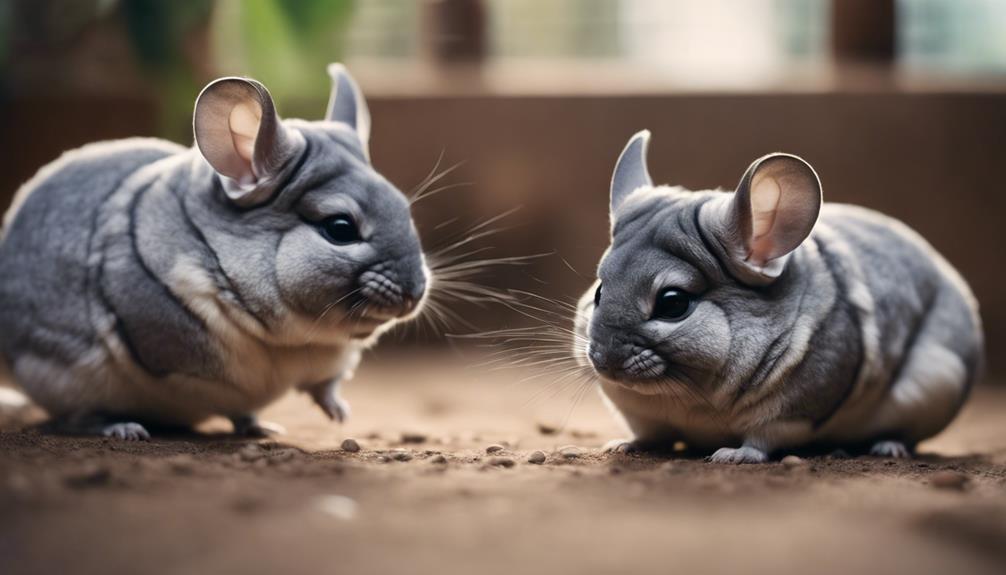
Chinchillas exhibit intricate group interaction patterns that help establish social hierarchies within captive settings. Understanding the dynamics of social behavior and group structures among these small mammals is crucial for their well-being in artificial environments.
Observing group interactions and hierarchy dynamics can provide valuable insights into chinchilla behavior and contribute to their optimal care in captivity.
Group Interaction Patterns
Group interaction patterns among chinchillas in captivity reveal intricate social dynamics that play a crucial role in their overall well-being and behavior. Play behavior dynamics and social bonding are essential components of chinchilla group interactions. Through communication signals and group cohesion, chinchillas establish hierarchies and maintain social order within their groups. Understanding these interaction patterns is fundamental for ensuring the welfare of chinchillas in captivity. The table below provides an overview of common group interaction behaviors observed in chinchillas:
| Interaction Behavior | Description |
|---|---|
| Play Behavior | Includes chasing, hopping, and wrestling |
| Social Bonding | Mutual grooming and sharing of resources |
| Communication Signals | Vocalizations, scent marking, and body language |
| Group Cohesion | Cooperative foraging and huddling together |
Social Hierarchy Dynamics
Within chinchilla social groups, individuals exhibit distinct behavioral patterns that signify their position within the established hierarchy. The dominance hierarchy among chinchillas plays a crucial role in shaping their social interactions and group dynamics. Some key points to consider include:
- Dominant chinchillas often display assertive behaviors such as scent marking and vocalizations to establish their authority within the group.
- Subordinate chinchillas may exhibit submissive behaviors like grooming higher-ranking individuals to maintain group harmony.
- Agonistic interactions, such as chasing or mounting, are common among chinchillas vying for a higher rank within the social hierarchy.
Understanding these dominance dynamics is essential for creating suitable captive environments that support healthy social structures among chinchillas.
Influence of Diet and Foraging
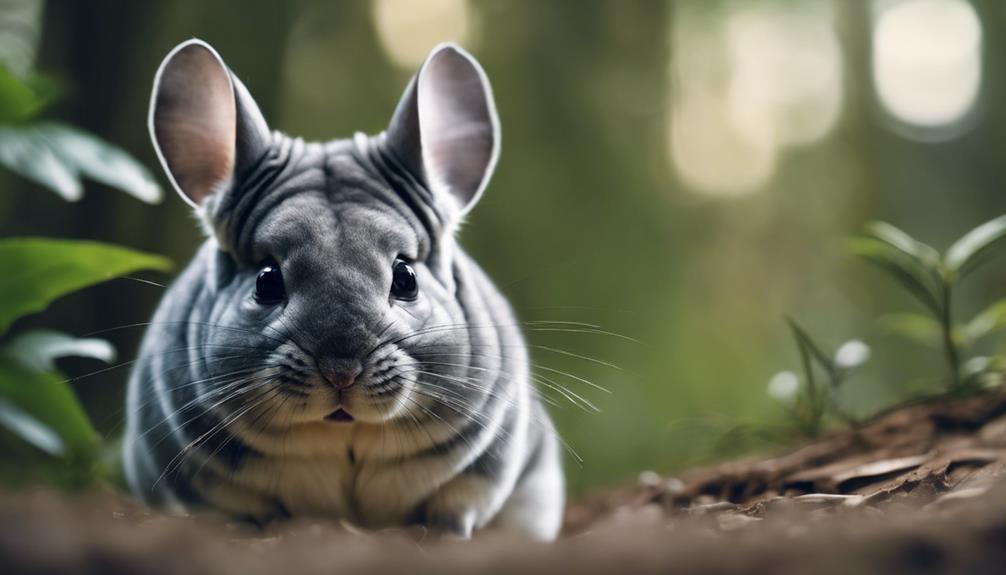
When considering the influence of diet and foraging on chinchilla behavior in captivity, it's essential to examine how these factors impact their overall well-being and activity levels. Chinchillas exhibit specific foraging behaviors influenced by their natural habitat, leading to unique dietary preferences. In captivity, replicating this foraging behavior is crucial for their mental and physical health.
Food selection and feeding strategies play a significant role in mimicking their natural environment. Chinchillas are selective herbivores, preferring hay, pellets, and limited fresh fruits and vegetables. Providing a varied diet not only meets their nutritional needs but also stimulates natural foraging instincts, promoting physical exercise and mental stimulation.
Additionally, the way food is presented, such as hiding treats or scattering hay, can encourage active foraging behaviors. Understanding and catering to these dietary preferences and foraging behaviors are essential in maintaining the well-being and activity levels of chinchillas in captivity.
Impact of Environmental Enrichment

Introducing various forms of environmental enrichment has been shown to profoundly impact the behavioral repertoire and overall well-being of chinchillas in captivity. Behavioral stimulation through enrichment techniques plays a crucial role in maintaining the physical and mental health of these animals. Environmental diversity within the enclosure design is essential for chinchillas to exhibit natural behaviors and prevent boredom or stress.
- Providing a variety of toys and structures for climbing and exploration can encourage chinchillas to engage in physical activity and prevent lethargy.
- Offering tunnels and hiding spots mimics their natural habitat, promoting a sense of security and reducing anxiety.
- Rotating toys and rearranging the layout of the enclosure regularly can stimulate curiosity and prevent habituation, keeping the chinchillas mentally active.
Reproductive Patterns in Captivity
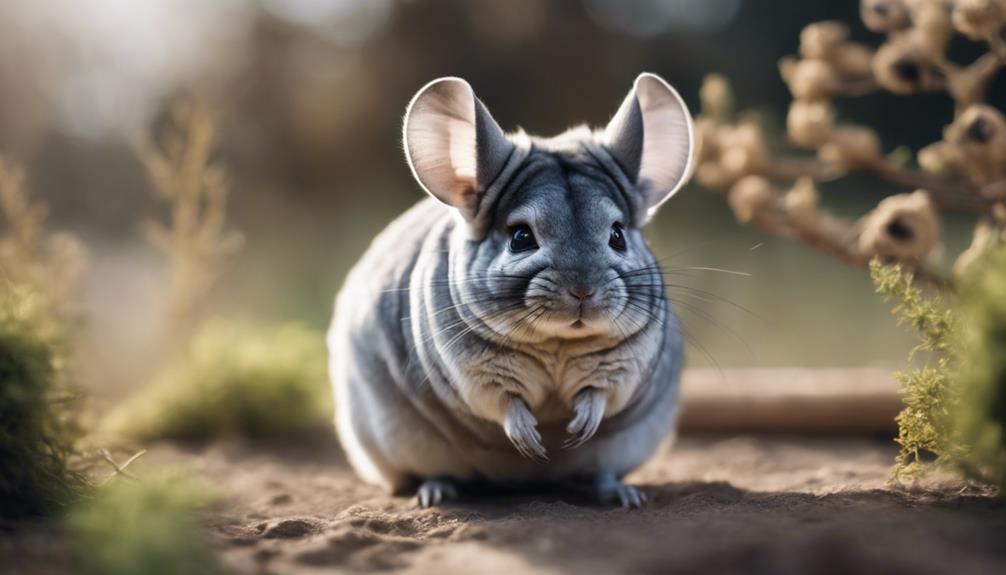
The implementation of appropriate environmental enrichment strategies not only impacts the behavioral well-being of chinchillas in captivity but also influences their reproductive patterns significantly.
In captivity, chinchillas' breeding habits can be closely tied to their living conditions. Providing a stimulating environment that mimics their natural habitat can positively influence their reproductive success.
Mate selection among chinchillas in captivity is a crucial aspect of their reproductive patterns. Chinchillas are known to be selective when choosing a mate, often engaging in intricate mating rituals before successful copulation occurs.
Understanding and replicating these behaviors in captivity can enhance their breeding success rate. By observing and respecting their natural instincts, caretakers can create an environment that supports healthy mate selection and mating rituals, ultimately contributing to the overall well-being and reproductive success of chinchillas in captivity.
Stress and Adaptation to Captivity
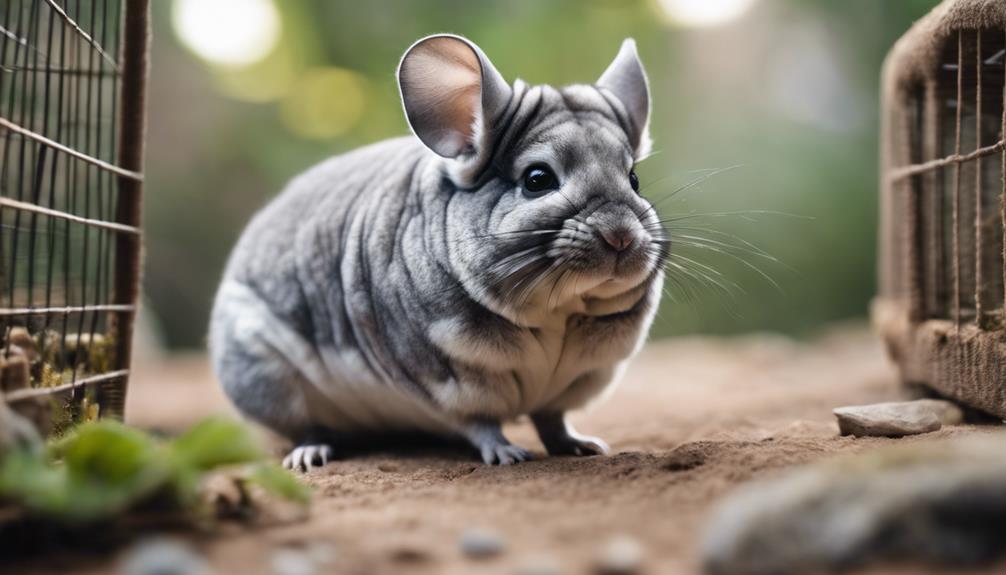
Chinchillas in captivity may experience various stress factors such as limited space, social isolation, and altered feeding habits. To adapt behaviorally, they might exhibit coping mechanisms like increased grooming, territorial behavior, or reduced activity levels.
Understanding how chinchillas cope with the challenges of confinement is crucial for ensuring their well-being in captivity.
Captive Stress Factors
In captivity, chinchillas face various stress factors that can impact their ability to adapt to their new environment. These stressors can hinder their overall well-being and require careful management. Some key factors contributing to captive stress in chinchillas include:
- Limited Space: Confinement in small cages can lead to feelings of restriction and discomfort.
- Monotonous Environment: Lack of environmental stimuli can result in boredom and decreased mental stimulation.
- Social Isolation: Chinchillas are social animals, and isolation from conspecifics can lead to loneliness and stress.
Understanding and addressing these stress factors through appropriate stress management strategies and providing behavioral enrichment are crucial for promoting the welfare and adaptability of chinchillas in captivity.
Behavioral Adaptation Mechanisms
Behavioral adaptation mechanisms play a crucial role in how chinchillas respond to the stressors of captivity. Chinchillas, with their predatory instincts finely tuned by evolution, possess exceptional sensory acuity which aids in detecting and responding to potential threats. In a captive environment, these instincts may be triggered by unfamiliar sounds or movements, leading to stress.
Additionally, chinchillas exhibit strong territorial defense behaviors in the wild, marking their areas with communication signals to assert boundaries. In captivity, this territorial nature can manifest as aggression towards perceived intruders or even cage mates. Understanding these natural behavioral adaptations is crucial for creating a suitable captive environment that minimizes stress and promotes the well-being of chinchillas.
Coping With Confinement
As captivity imposes constraints on their natural behaviors, chinchillas undergo a complex process of stress adaptation to cope with confinement challenges. To help chinchillas adapt positively to captivity, it's crucial to provide them with enrichment activities for mental stimulation and exercise opportunities for physical health.
These interventions can significantly improve the well-being of chinchillas in captivity by reducing stress levels and promoting natural behaviors. Enrichment activities engage their natural instincts, preventing boredom and encouraging mental acuity. Exercise opportunities, on the other hand, promote physical health, preventing obesity and muscle atrophy.
Behavioral Challenges and Solutions
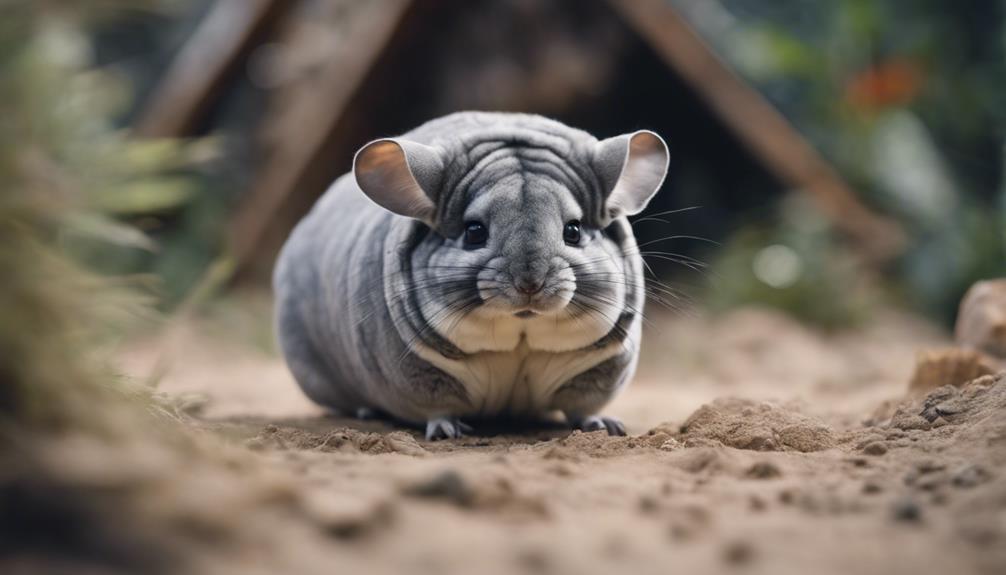
Unraveling the complexities of chinchilla behavior in captivity presents challenges that require innovative solutions. Handling techniques and training methods play a crucial role in addressing behavioral challenges. Chinchillas are naturally skittish and may exhibit aggression when feeling threatened. Gentle handling techniques combined with positive reinforcement training methods can help build trust and reduce fear responses in captivity.
Behavioral modifications are essential for chinchillas exhibiting stress-related behaviors such as fur chewing or excessive hiding. Providing enrichment strategies like chew toys, tunnels, and dust baths can stimulate their natural behaviors and prevent boredom. Additionally, creating a stimulating environment with hiding spots and climbing structures can promote physical and mental health.
Understanding the chinchilla's natural behaviors is key to implementing effective solutions in captivity. Observing their social interactions, activity patterns, and preferences can guide the development of tailored enrichment activities. By incorporating appropriate handling techniques, training methods, and enrichment strategies, chinchilla owners can promote positive behavior and enhance the well-being of these adorable creatures.
Frequently Asked Questions
Can Chinchillas Be Trained to Perform Tricks or Tasks in Captivity?
Chinchillas can be trained to perform tricks or tasks in captivity using positive reinforcement training techniques. Mental stimulation through enrichment activities helps keep them engaged and motivated to learn, showcasing their intelligence and adaptability.
How Do Chinchillas in Captivity Interact With Other Household Pets, Such as Dogs or Cats?
In captivity, chinchillas show nuanced playtime dynamics with household pets. Interspecies relationships vary, with careful introductions recommended. Chinchillas may establish cautious friendships with calm dogs or cats, but supervision is crucial to ensure safety and positive interactions.
Are There Specific Toys or Activities That Are Recommended to Keep Chinchillas Mentally Stimulated in Captivity?
Chinchillas benefit from enrichment ideas like tunnels and chew toys for mental stimulation. Behavioral challenges arise from their need for environmental adaptation. Providing a variety of activities can help chinchillas thrive in captivity and exhibit natural behaviors.
Do Chinchillas Exhibit Different Behaviors Based on Their Gender in Captivity?
Chinchillas exhibit gender differences in captivity. Males tend to be more territorial and assertive, while females may display more social behavior. Understanding these distinctions can help in creating enriching environments tailored to their specific needs and behaviors.
What Are Some Common Signs of Stress in Chinchillas Kept in Captivity, and How Can These Be Addressed?
In captivity, signs of stress in chinchillas include decreased appetite, excessive grooming, and aggression. To address this, providing enrichment options like toys and hiding spots, along with behavioral modifications, such as creating a quiet environment, can help alleviate stress.











